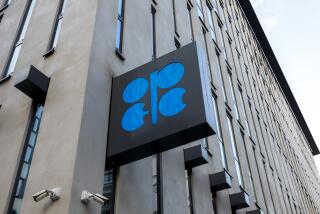Oil caps strongest year since 2016 on OPEC cuts, trade truce

Oil in New York capped its biggest annual increase since 2016, as OPEC’s production cuts tempered supplies while a trade pact between the U.S. and China buoyed the outlook for demand.
West Texas Intermediate futures fell 62 cents, or 1%, to $61.06 a barrel Tuesday, yet climbed $16, or 34%, in 2019 as OPEC and its allies cut production and a trade deal between Washington and Beijing neared. With hedge funds’ net-bullish bets at a seven-month high, even protesters storming the American embassy in Iraq, OPEC’s second-biggest producer, couldn’t support prices on the final trading day of the year.
“The U.S.-China trade war was in the driver’s seat when we entered 2019 and remains there as we exit the year,” said Vandana Hari, founder of industry consultant Vanda Insights in Singapore.
Prices initially picked up Tuesday as dozens of Iraqi militiamen and their supporters stormed the U.S. Embassy complex in Baghdad to vent their rage over deadly American airstrikes against an Iranian-backed force.
The U.S. had launched air strikes on five bases in Iraq and Syria used by an Iranian-backed militia as a warning to Tehran over its aggressive moves in the region, the State Department said. The attack heightened concerns of destabilization in Iraq, which pumps nearly 5 million barrels of oil each day, or roughly 5% of global supplies. Iran, which the U.S. blamed for September’s strike on Saudi Arabia and earlier attacks on oil tankers, said this week that it had detained a ship carrying smuggled fuel near the Strait of Hormuz.
“The market is looking past the Iraq developments at this stage, as it is unlikely that there will be an impact on supply in the near term,” says Bart Melek, head of global commodity strategy at TD Bank in Toronto. “Any attempt by Iran to disrupt Iraq supply is not a factor at this time.”
Oil markets have faced a tumultuous year, with much of WTI’s gains coming in its first few weeks. Prices saw their steepest one-day loss in four years on Aug. 1 after President Trump threatened to impose more tariffs on China, then soared the most in more than a decade in September when key oil facilities in Saudi Arabia were disabled in a missile attack.
Brent crude for March settlement fell 67 cents, to $66 a barrel, on London’s ICE Futures Europe exchange Tuesday. The commodity ended the year 23% higher, posting the biggest annual gain since 2016.
In 2020, oil prices are likely to remain in check as OPEC+ production cuts are offset by higher output from other countries and a mixed outlook for demand, analyst forecasts show. Nevertheless, prices are seen climbing in the middle of the year amid stronger emerging-market consumption.
More to Read
Inside the business of entertainment
The Wide Shot brings you news, analysis and insights on everything from streaming wars to production — and what it all means for the future.
You may occasionally receive promotional content from the Los Angeles Times.










